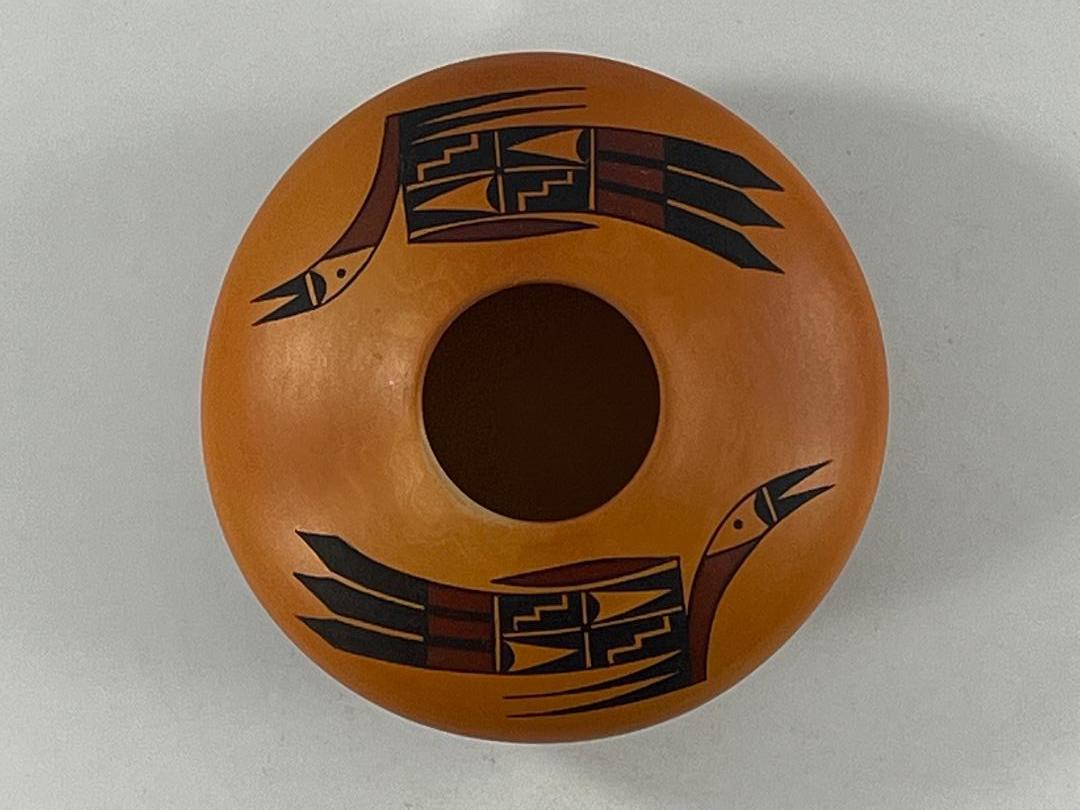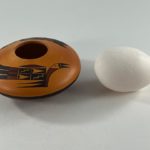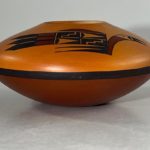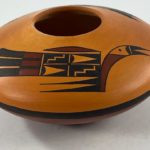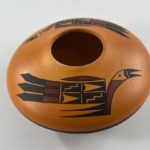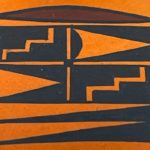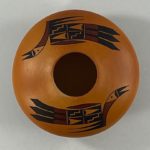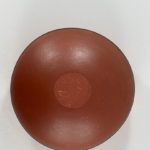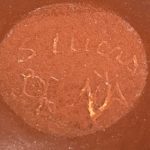The design on this jar has a large impact, but its detail is minuscule. Without a reference point a viewer might guess this perfectly formed and painted jar to be many times its actual size. It’s a gem of pure beauty and joy: birds gliding with energy in an unlimited, small, space.
Form:
The pot rests on a 1.125-wide base and then slopes outward for 1.75 inches to its waist, where it turns sharply inward another 1.75 inches to its mouth. The form is a perfect saucer floating on a small base.
As expected, the puki-formed base is somewhat thicker than the walls of the jar. The walls thin further as they approach the jar’s mouth.
Design:
Below the waist jar 2021-18 is finished in Steve’s maroon-red micaceous slip. At the waist a single broad black stripe encircles the jar; above the surface has blushed a rich gold color from the firing. This blushing is so uniform that I thought it might be an applied slip, but variations in its color on the edge of the rim suggest otherwise.
The design is simple: two Sikyatki birds on opposite sides of the jar. The birds are identical and are 2.875-inches long. Two black acute triangles form the open beak; a thin unpainted strip supports their base. A solid black hill is based on the far side of this gap. Following is a curved unpainted area containing a single black dot, giving the bird sight. This head is based on a long curved maroon-red neck that is set against the body of the bird. The neck does not grow out of the body but simply attaches itself to it, as if it had been riveted in place.
The core of the body is a black rectangle with feathers attached to its outside and areas of unpainted surface on its interior forming design elements. Flying off the top right corner is a leaf-shaped maroon-red feather attached to the body by only a slight black line. Pendant from the lower right corner of the body are two elongated right triangles, their right edge providing much of the attachment point for the neck. Vertical and horizontal unpainted lines seem to cross to subdivide the rectangular body into four quadrants, but a more careful look reveals that at their juncture is a tiny solid black rectangle. Thus, as can be seen in the photograph above, it is more accurate to say that from a tiny black square at the center of the body four unpainted lines emerge to subdivide the space into four quadrants.
Quadrants diagonal to each other contain the same design elements. The upper right and lower left quadrants contain an unpainted arrowhead form pointing right set against a black background. Background/foreground reversal changes perspective. In this case these quadrants can also be seen as unpainted areas into which intrude two right triangles based on the right wall and another black hill based on the left wall. The upper left and lower right quadrants are solid black but are diagonally bifurcated by an unpainted line with two steps.
The left end of the rectangular body is marked by another thin unpainted strip. Growing from its left edge are three tails with maroon-red bases and black pointed tips.
Design analysis:
Some pots carry designs that need to be studied and untangled to be understood (cf 2021-21). In contrast, without discussion, the design on jar 2021-18 speaks directly to the eyes and heart. The heads of the birds point proudly into the wind while the three sets of feathers give a forward thrust into an unbounded golden sunset.
Although I am partial to pots formed inexactly in a folk art tradition, the exactitude of Steve’s painting works well given the small scale of the design; there’s little room for error. The precision of his painting is best illustrated by the most insignificant element of design: that small square at the juncture of the cross-cutting lines in the rectangular body. Unless you look very closely, this detail is lost. When seen closely both examples are perfect microscopic squares. Dedication to such precision is a tour de force, though the term generally refers to grandiose gestures. I imagine that Steve chose this more difficult layout as a test of his ability and a commitment to a high standard of craft, even if others might not notice. His drawing is like a fine piece of jewlery: each element fits perfectly with its neighbor. Thus perfection is a long way from the talented inexactitude of his earliest pottery (2021-20).
The red feather that is above and semi-detached from the bird’s body is common on Sikyatki Revival birds (cf 1998-10, 1999-07 and 2016-06).
Note that if the upper-right/lower-left diagonal in the bird’s body is seen as black elements against an unpainted background, these same elements (right triangles and a hill) are used to construct the bird’s beak area. This pattern links three areas of design, though this might be subliminal.
The unpainted stepped line in the other diagonal (upper left/lower right) is generally understood to represent the shape of cumulus clouds with their promise of the blessing of rain. The steps of kivas may take this same form, as a sort of prayer.
The maroon-red micaceous clay that Steve used to cover the lower half of jar 2021-18 requires special treatment during firing. Pots with this slip are fired upside down, taking special care to avoid damage to the slip or the rim. Micaceous clay is frequently used by potters of the northern New Mexico pueblos, but Steve seems to have introduced it to Hopi:
“My aunt Dextra had a deep red color of clay slip, and I decided to experiment with it. I took some of our base clay and added the red to it and polished it very well. I then decided to put some mica in there to get that sparkle. That’s where the red came from, and Dextra liked how it turned out. I introduced them to that. It was nice that for my teacher, Dextra, I was able to share and teach her something (King, 2017:90).”
For other pots by Steve using this slip, see 2010-23 and 2017-09. In addition to Steve, Dextra trained a group of younger Hopi potters, including Loren Ami and grandson Lowell Cheresposy, These potters have used the same red-maroon micaceous slip seen on 2021-18 to cover the lower half of their pots. (See 2011-23 and 2011-26).
Seedjar 2021-18 reminds us that great art need not be of great size. I have the same visceral response to it as I do when I look at a beautiful gem, which it is.

